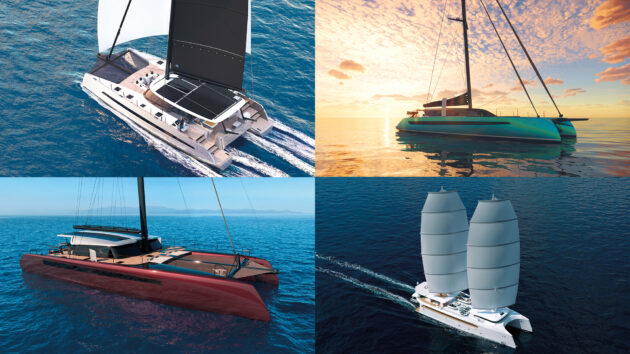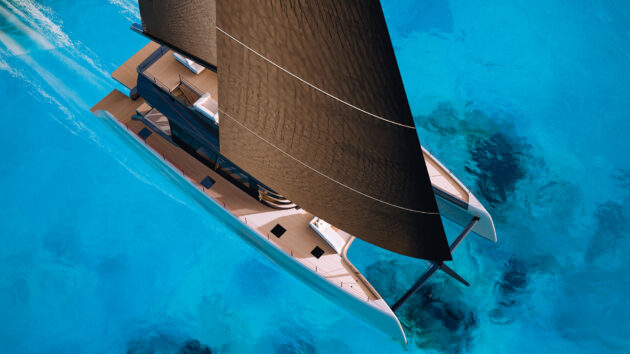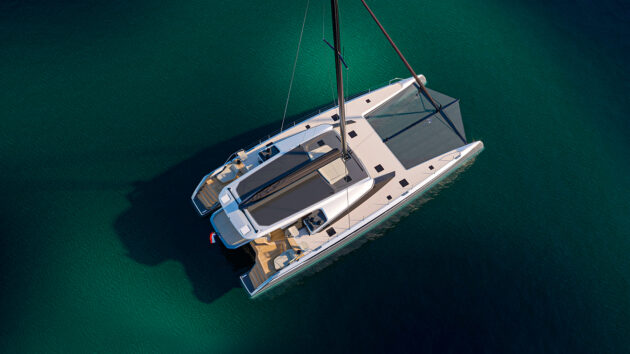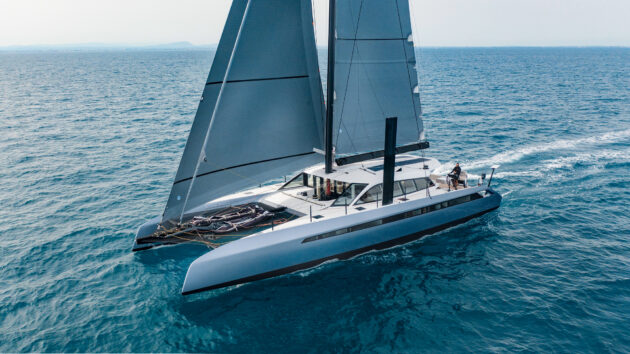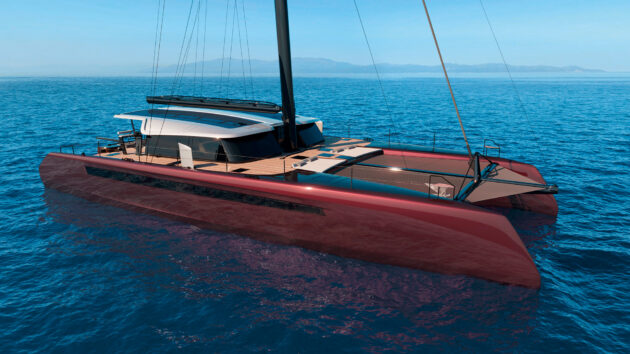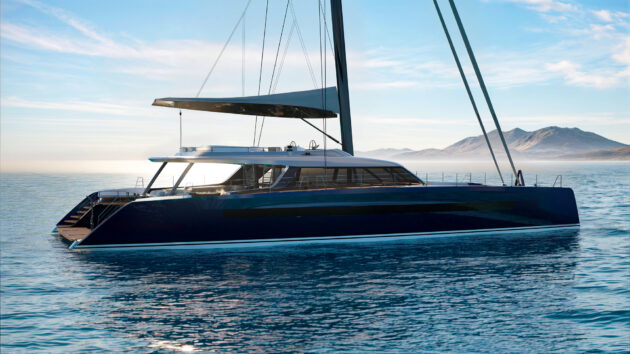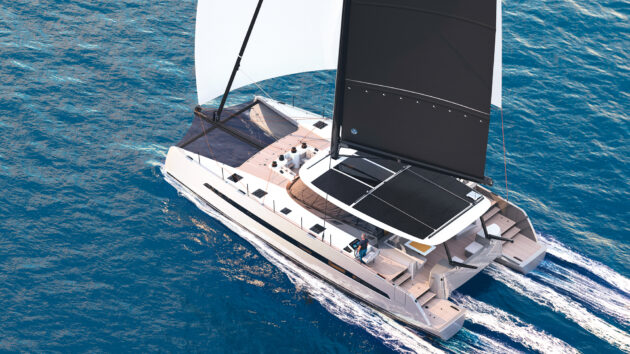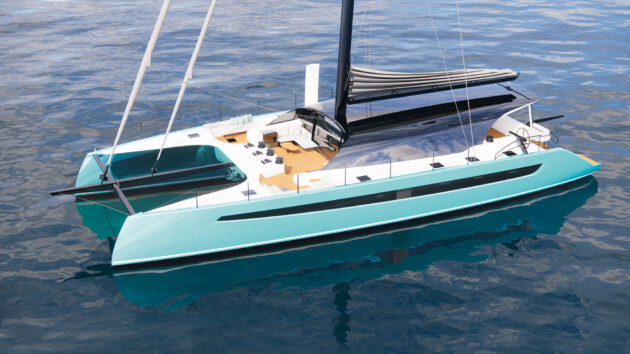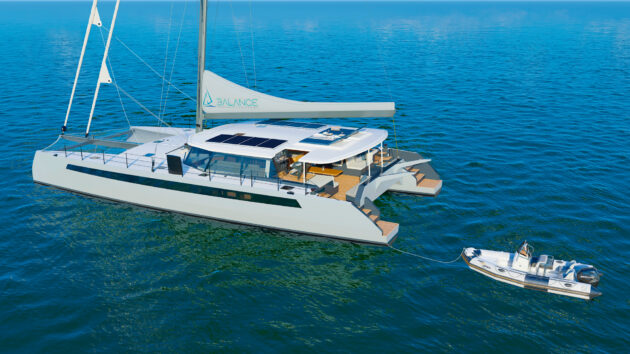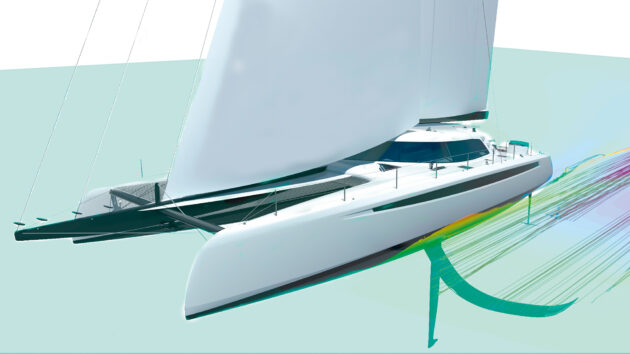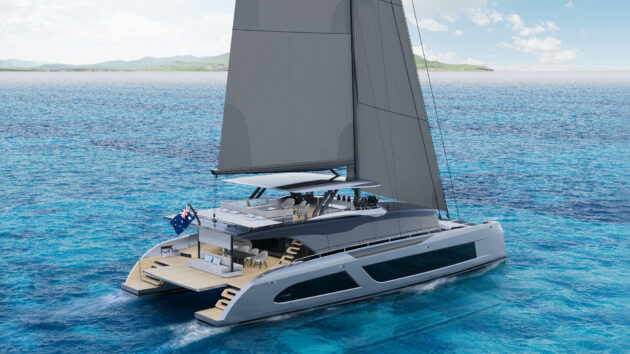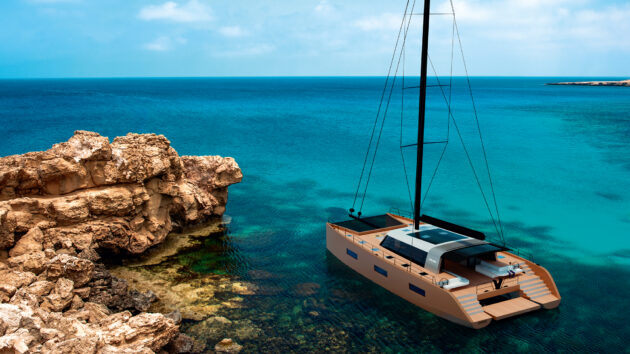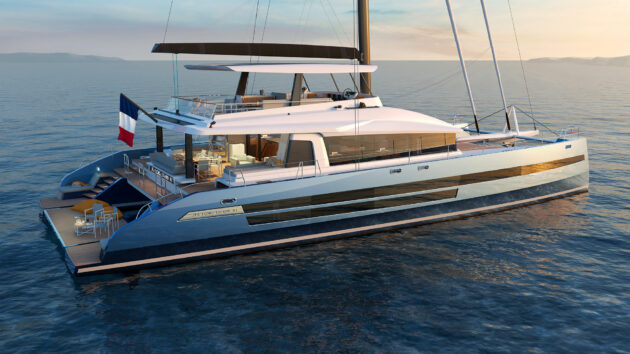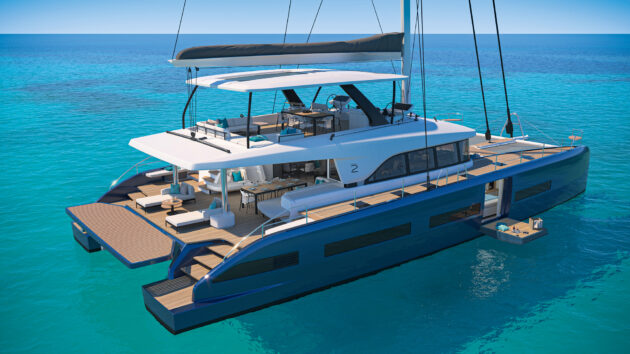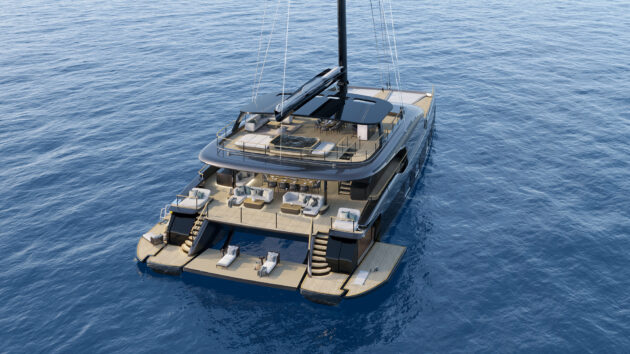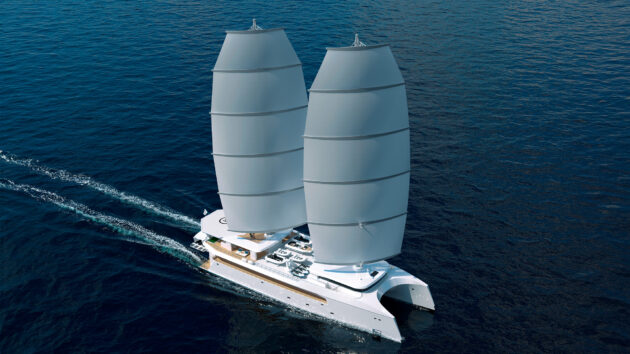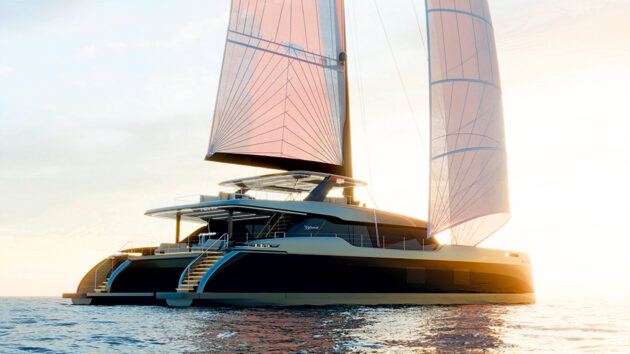The latest wave of performance luxury multihulls is bigger, faster, and more luxurious than ever. Toby Hodges reports on the continued rise of the big cat
There’s been the odd singular sailing superyacht thus far, the likes of the 44m Pendennis-built Hemisphere and Perini Navi’s recent 46m floating art gallery ArtExplorer, while JFA has quietly gone about launching a handful of 85-110ft custom sailing catamarans.
But a new pride of big cats is coming. Last year John Mountain launched his carbon bluewater sailboat Air Yacht 80 after failing to find his preferred blend of performance, space and superyacht quality.
And it’s the performance element which has triggered this new trend that we centre on in these pages. Yachting World readers will have noticed a similar movement with monohulls of late, where production yards have stepped up to cater to a semi-custom demand in the 70-90ft sector.
We dedicated these pages to them two years ago, detailing the latest launches from YYachts, Solaris, Grand Soleil, CNB, Ice and Swan. Now with an increasing number of sailors seeking that size, style and speed combination on two hulls, it’s fuelled a real surge of new, big (and mostly fast) cats.
Gunboat can arguably be credited with igniting this performance cruising cat cult and we’ve been writing about and reviewing a multitude 45-60ft fast cruising cats in YW in recent years. Now they’re growing in size, space and pace. McConaghy, Balance, Kinetic, Advanced Yachts, Black Pepper, Cure Marine and HH are all producing or have recently launched varying levels of performance cats around the 70ft region.
Typically, these involve carbon or E-GRP lightweight composite construction, ultra fine bows, and powerful rigs with booms kept low down. Where Gunboat and HH are taking it to the next level of luxurious lightweight performance, we can see the needle shifting further still, and at each end of the spectrum too.
Article continues below…
The best bluewater multihulls of all time: a complete guide
What are the best bluewater multihulls for long term cruising? The one you own, or the one you can afford…
Best Yachts of 2025: European Yacht of the Year 2025 Winners
The European Yacht of the Year 2025 winners were announced this evening, Saturday 18 January 2025 on the first night…
At its sharpest, Persico’s new foiling 72 is being tested by the American Magic team and will surely prove the most rapid ‘cruise-equipped’ multihull to date. Thrill seekers should also check out S6’s dynamic foil-equipped Infinti 72 design, and the latest images of Daedalus’ jaw-dropping D75, D100 and D165 projects.
For the large part of the market less obsessed by speed comes the real space race that multihull platforms can provide – a market cornered by production yards Sunreef, Lagoon and Fountaine Pajot over the last decade, but one also seeing some evolution.
Think flybridges like flats, drop-down balconies and freestanding designer furniture, albeit combined with innovation in greener materials, propulsion and solar technology. Scaling up further, Echo Yachts in Australia is well into the secretive build of a monster 58m catamaran superyacht, which will go straight in to claim the spot as the world’s largest sailing multihull.
Welcome to a new era of Super sailing, that of supercats, megacats, and particularly the performance-oriented maxicats.
New MaxiCats – Space & real pace
Advanced AC72
Italian boutique yacht builder Advanced Yachts has turned its attention for the first time to multihulls. Active in the 60-80ft monohull sector, Advanced offers semi-custom yachts with fine Italian styling requiring a small crew of two or three.
It has started building the moulds for a 72ft catamaran that fits the same brief, with naval architecture by the renowned Reichel/Pugh. Performance is certainly an important consideration, but this is really designed to be a comfortable offshore cruising cat for bluewater cruising – or just loafing round the Med. It’s built in E-glass with a carbon-fibreglass deck and superstructure to keep the centre of gravity down and displacement to 35.5 tonnes.
The former is important when you add in the low-profile flybridge and towering carbon rig from Lorima. It also uses 4m-deep centreboards which lift into the boat hulls. “We have a higher power-to-weight ratio than anything else in the crewed yacht cruising capability class,” said sales director Jay Nolan.
“We put Gunboat and one or two others really in a separate Grand-Prix class. We’re not as powerful as that – we’re specifically stopping short of the most frightening performance where cats are a little edgy.”
Sail handling and navigation is all brought back to the flybridge, allowing the yacht to be sailed by a couple. The electric rudder control means it would also be easy to put a helm at the nav desk in the shelter of the saloon. “We’re building-in the ability to have protected controls not just with canvas on the flybridge,” added Nolan.
This leaves the aft cockpit free for guests to relax. There’s also a forward cockpit to take advantage of the breeze at anchor. The main deck is flush, with glass doors aft sliding completely away to open up one big indoor-outdoor space.
Configuration and finish is a matter for individual owners, but the concept from Cassetta Design puts a master owner’s cabin in the port hull and three guest cabins to starboard, with space for two crew. A large hydraulic platform aft serves for bathing and watersport toys, or carries a tender up to 4.6m in length when underway.
Holld 74
This Dutch startup and Zwartsluis yard has a focus on luxury, aiming to put the super into performance cruising catamarans. The founders are using their two decades of carbon composite superyacht boatbuilding experience, combined with that of designers including Eliot Thorne, to offer full carbon semi-custom cats ‘as technically advanced as they are visually stunning’. Holld promises a bespoke build programme for each owner using hybrid-ready platforms, smart digital systems and flexible modular interiors. This first 74 is already in build.
“We didn’t set out to build another production multihull,” says founder Guido Achtelik. “We set out to re-engineer the category from the ground up, using carbon and epoxy infusion, digital build processes, and an obsessive focus on precision, longevity, and performance with a superyacht finish.” The launch of the brand will be during the Cannes show.
Gunboat 80 Agave & new model teaser
Agave has been tearing it up since she hit the water in last May, but this second version of Gunboat’s 24.65m flagship is decidedly a (swift) cruising boat. Where the red hull number one was always destined for the Highland Fling racing programme, hull number two was customised with a number of more cruising-friendly features, notably around the interior.
Make no mistake, though: in the words of Gunboat, this is still an ‘objectively epic sailing machine’! From the pre-preg carbon layup and rotating mast to retractable T-propeller rudders and daggerboards, Agave is designed in true Gunboat tradition for exhilarating performance.
The yard reports that she matches true wind speed from 5 knots and tops out at over 30 knots, while the foils on the rudders reduce pitching in oceanic swell by 30%. Grand Prix accessories include ECsix carbon rigging, titanium fittings and HydrauNautic hydraulics with pressure sensors and a quick-release system to de-power the mainsheet, Cunningham, outhaul and other key controls.
With 16 hydraulic controls, the boat is designed for short-handed sailing. There’s little detail about the cruising interior, but the standard design allows for three guest cabins and up to three crew.
Meanwhile, Gunboat is hinting at an exciting new product range to be unveiled at the Cannes Yachting Festival. The French yard is remaining tight-lipped about the details, but we know that the debut model will be an 80-footer and that it will have a flybridge.
“What we are about to reveal is not just another yacht,” said marketing director Rodolphe Cadoret, “It’s the birth of an entirely new segment in high-performance sailing – a project that fuses long-distance capability, refined onboard experience, and the unmistakable Gunboat DNA.” The veil will be lifted on 9 September, but Gunboat is likening the move to that which saw Porsche launch the Cayenne as its first luxury SUV.
Black Pepper Code C.69
French speed merchant Black Pepper is at it again – this time with a catamaran. Pitching its debut multihull at a punchy 69ft LOA, the yard has just revealed a second order – before the first has even been delivered. The two hulls have already been completed by partner Multiplast in Vannes and towed to Black Pepper’s premises in Nantes, where they dominate the build shed.
Infused in carbon fibre, the hull of the C.69 is light despite plenty of hull openings. In fact, the yacht only displaces 17.5 tonnes light – so perhaps 21-22 tonnes fully loaded – not bad for a 70-footer!
The yard says it did a lot of soul searching before launching the multihull project with designers François Pérus and Romain Scolari. The brief was ‘handsome, fast, safe and high-tech’. The result is eye-catching: reverse bows and a heavy, bevelled tumblehome with a low coachroof and a long bowsprit. There are sunbeds just ahead of the mast, while the helm stations on the quarters seem to float above the deck.
Accommodation runs to two large double cabins and a triple with a fold-down berth, supported by up to three crew. But the layout is flexible. The second boat will feature a hard bimini extending aft from the coachroof to cover part of the cockpit. Its helm stations have been simplified and brought further inboard, leaving clearer side decks.
And it will also have a hybrid diesel-electric drive. The first boat will be launched at the end of the year, the second in 2026.
Baltic 107
It was big news when performance yacht builder Baltic revealed its first multihull order last year. Berret-Racoupeau’s 33m low profile design includes a flybridge and a full-beam bathing platform aft as well as cabins for eight guests.
But the performance is what makes this boat stand out: pivoting centreboards, a huge sail area and high-tech lay-up in carbon Corecell sandwich. Since we last covered it, moulding is now complete in line with delivery in summer 2027. “With bulkheads installed, the two hulls have been released from their tooling and connected together via the wet deck midsection,” said Baltic’s Henry Hawkins.
“Further structural members will now be installed as well as the commencement of system and interior fit-out. We continue to receive enquiries regarding the boat and potential future catamaran projects.”
Kinetic K6
Kinetic Catamarans, builders of performance voyaging cats the KC54 and KC62, is launching a formidable-looking new K6 range. It will be officially announced at the Cannes Yachting Festival this September, but we have the exclusive preview after speaking with founder Bob Hayward and veteran boatbuilder Leon Scheepers.
K6 comprises a new 63 and a 67, the former is for private use, designed to fit into a 20m berth, the latter is more aimed at sailing with pro crew. This US-based brand builds semi-bespoke high-end carbon fibre cats from its yard in Kynsna, South Africa, which is currently completing an expansion and redevelopment, to help accommodate the new K6 range and more larger models to come.
Cannes will be the first time its yachts are available to view at a show in Europe, a key market having sold four KC54s here now.
Together with design partners Simonis Voogd, Kinetic specialises in clean lines and prefers not to have daggerboards sticking out through the decks. “We’re staying with centreboards as it’s a system that works very well,” Hayward explains.
Controlled by line drivers, these are contained below the floorboards. “Our yachts are world cruisers, so if you hit something like a coral head, a weak fuse allows it to automatically ride-up. Replace the fuse and you’re back sailing in 20 minutes,” he adds, having tested the theory on his own KC62 in the Pacific.
The powerful sail plans are offered with slab-reefing or in-boom furling. Opting for a push-button controlled mainsheet and traveller plus furling sails makes the 63 manageable short-handed. Note, the traveller is led to the coachroof, which takes significant structural engineering, but keeps the aft cockpit free for a leisure zone.
A luxurious forward cockpit sees sunbeds built into the deck and a retractable awning above. Kinetic won’t do a flybridge, but its forward helm stations are key for its owners, close to the sail controls. The K6 also has twin exterior wheels on distinct mezzanine levels for optimum visibility.
Superyacht vibes continue with a wide fold-down swim platform, carbon davits that fold out of the roof supports and bulwark side doors. The port hull offers a full owner’s suite, including an office, with its own private access aft. These are 48V powered yachts, including the aircon and refrigeration, and use Integral E-drives delivering up to 15kW each into the house batteries bank.
Stay tuned for more to come in the next couple of years from this maturing brand.
HH80
If there does happen to be anyone left out there still thinking cats don’t look cool, then perhaps show them a picture of the HH80. This bang-up-to-date Morrelli & Melvin turbo cat might be the only beast out there to get near a Gunboat 80’s performance. A carbon epoxy build with prepeg boards, it has a 30m-high mast and is capable of hull flying. Can you imagine that?
HH says it has the lowest boom in class for a low centre of effort and fast, smooth ride. While the light displacement figure is not given and will depend on interior fitout, a generous cruising payload weight of up to 40 tonnes is presented. HH has some form at this supersize level too, having delivered the HH88 two years ago.
It’s since been flat-out building its latest range, the new 44s, 52s and 56 to come. The HH80 appearance is all curves and muscle, from the reverse bows to sculpted sections of the coachroof, which help fashion forward and aft cockpits. Below that glass-look roof is a multitude of solar panels (around 11kW) on the carbon superstructure.
A self-tacking jib could be controlled by a captive winch for more short-handed operation, and M&M’s predictions are it could offer sparkling cruising ability with 250+ mile days possible in just 12 knots breeze! The design affords real space to the forward cockpit, with the winches and sail handling set well forward at the start of the longeron.
Walking through the sliding doors from there to the main saloon must be like entering the Starship Enterprise (you can almost hear the ‘swoosh’ noise of the doors). At 79ft, it offers the most space and speed available without falling into restrictive big yacht coding.
The HH80 is designed to suit six to eight guests with space for two to three crew in dedicated accommodation.
Balance 750
Balance is a US/South African brand/build which has really created momentum since its 2013 inception with a range of refreshing performance voyaging cats packed with practical and original thinking. And now it’s gone big, with a new flagship 750 that launched in Cape Town earlier this year, named Some Day. Balance claims it will redefine luxury and speed.
The company is named so for good reason, aiming to hit that balance of speed and agility using fine hulls with daggerboards paired with airy, modern comfort. The 750 adds a liberal sprinkling of luxury into the mix. This is also the first Balance with a forward cockpit, linked to the saloon via a waterproof door.
Offering another relaxation zone, this also houses the primary winches at the mast base, so the boat can be trimmed from forward or controlled from either aft helm. We particularly like the inboard station Balance has designed, allowing its swing wheel VersaHelm to cant to a fully protected steering position.
A powerfully rigged yacht, the 750 is controlled using a full hydraulic system, including rams in the boom, mast, beams, and captive winches. This promotes short-handed use, so two or three hands can sail and operate the yacht. It’s also a sleek-looking design by Anton Du Toit, with low hulls and roof.
A flybridge is an option, and Some Day has an in between ‘flylounge’ to give some sunlounger space between the solar field. The interior shows how the UK’s Design Unlimited is one of the world’s best at combining superyacht glam with lightweight materials. Furniture is all foam cored styled with wood veneers, in accommodation laid out with four or five cabins with or without crew quarters.
The hulls, deck and structure are foam cored too, keeping displacement to 32 tonnes. Infused E-glass is predominantly used for noise insulation, while there’s also plenty of carbon reinforcement in high-load areas and bulkheads.
Persico Cat 72
Construction work on this 72ft speed project by Persico Marine has continued since 2023 behind a veil – until January this year, that is. The finished hull was revealed in a series of images which show just how narrow its twin hulls are, and how they are allied to a low-profile superstructure.
An enormous longeron dominates the forward half of the boat, which wastes no weight in fripperies such as foredecks. Underlining the performance potential of this 21.5 tonne Morrelli & Melvin project, American Magic has ‘come on board’, with sea trials and fine-tuning of the boat, shifting to the team’s base in Pensacola, Florida.
Persico promises it will ‘push the yacht to its limits’. And those limits look to be pretty far out, thanks to a full set of foils that are designed to keep the hulls flying just above the water. There are rake-controlled righting-moment foils (RMFoils) over 7m in length, daggerboards for leeway control, and T-rudders with rake control. The whole set-up is integrated with Gomboc’s Flight Control System, which manages the foil angles of attack.
Expectations are that the RMFoil is beneficial from wind speeds of around 9 knots and allows the yacht to skim at 20 knots in just 13 knots of true wind. Persico reports that the system will automatically lower the flight of the boat and manage speeds according to the owner’s preference.
Nonetheless, a crew of at least three is required to sail with a choice of two exterior helm stations or a protected interior wheel, which gives access to mainsail management and all flight controls. The yacht has a pared-back, modern interior from Design Unlimited.
And despite potential speeds of up to 40 knots, Persico describes it as possessing ‘the comfort of a cruising vessel’. The coachroof is studded with 2kW of solar panels and the yacht features electric boats propulsion.
Supercats – Size & some speed
McConaghy Sapphire Plus MC & Panther
While it built its name on its high-performance and record-breaking maxi monohulls, McConaghy has proved that it can build anything, from AC40s and their hydrogen chase boats to a deep-sea submersible. It’s also no stranger to multihulls, including its largest craft to date, the sensational, futuristic 42.5m trimaran Adastra, which launched 10 years ago. Latterly, it’s really honed in on the large cruising multihull market, with its MC range of sailing cats.
These Jason Ker designs, with their signature flybridge-mounted aft helms, began with the MC50 in 2018, and grew to include last year’s spectacular launch, the MC75 Jack. Such has been the interest in these large cats that McConaghy has recently conceived two full new ranges: a Panther line of electric hybrid yachts from 48-68ft and a Sapphire range of super spacious supercats from 70-115ft. Both are, of course, carbon builds, the forte of this yard.
The Sapphire range looks to be going after more of the Sunreef space race market, albeit with distinctly more sailing focus. Despite Sapphires aiming to offer ‘the largest interior volume in the world relative to their size’, they should still sail well. The yard predicts they’ll be able to average speeds in the teens – in 20 knots the S80 should reach at almost 14 knots, and could even hit 20 knots on its day. Now that would be a sight!
Retractable composite centreboards drop 5m down from the hull at the push of a button to help offer pointing ability, while sail handling systems use advanced push-button technology to make operation by a small crew easy. In terms of comfort, these highly voluminous yachts won’t be lacking. A hard bimini covers both the forward and aft cockpits, while the side windows can open out at the push of a button.
Vaan R8
An aluminium supercat. After all, it’s the material of choice for the majority of monohull superyachts. Vaan has been quietly making a name for itself as a specialist in luxury aluminium multihulls with a focus on greener building. Its 40ft R4 and 50ft R5 have proved its use of recycled and fully recyclable aluminium as a viable material for its semi-bespoke electric powered yachts.
Our full review of the R5 follows next month, but suffice to say when you board this yacht and appreciate the finish quality and particularly the natural light the huge coachroof windows bring (thanks to the stiff structure), it’s easy to picture the appeal of scaling up the design. Reassuringly, the naval architecture is once again by fellow Dutch firm Dykstra, world-class superyacht designers.
Vaan likes to keep the boom low for performance, so no flybridge on the R8. There is, however, an internal helm, linking to a forward cockpit, and when you combine these with the saloon and aft cockpit, it equates to formidable single-level living space.
Siting the galley down to starboard amidships will also emphasise this space. And it’s designed like a superyacht, so the crew quarters forward link to the galley, mess and the bridge. Elsewhere, there’s space for five guest suites, but another benefit of aluminium is that each yacht is built to order so layout can be adaptable to suit.
Equally, aft helms or benches can be chosen, a crane, davits, swim platform etc. The R8 will be powered by two electric engines with two diesel range extenders and a 100kWh battery bank. Displacement is predicted to be between 35-40 tonnes. Construction of the R6 is due to start later this year and Vaan has several serious prospects for this R8, a project born from demand, founder Igor Kluin confides.
JFA 87
French yard JFA has been working with fast cruising monohull and multihull expert Marc Lombard on a successor to its 85ft sailing catamaran for a couple of years, and the new design is now well in build. Measuring 87ft LOA, it has an extended flybridge, featuring a new navigation station, a sheltered bar and a large saloon, with solar panels on the hardtop.
Franck Darnet’s interior uses the 11m beam to deliver a huge social space flush with the cockpit, and a wonderful owner’s cabin forward at deck level. The aluminium hull has been completed and was recently married with the glass-epoxy composite deck, allowing interior systems to start going in.
Cabinetry is already taking shape. The US-based owner plans to sail round the world with a family of four.
Lagoon Eighty 2
We featured this yacht in our Cannes show preview last issue, where it will be making it’s world debut this autumn. The hull design comes just below the 24m mark in terms of class, making the boat an attractive candidate for charter, just like its 77ft predecessor.
Key features of the new model include a large 50m2 flybridge with a hard-top and optional Jacuzzi, plus a wide lifting bathing platform that extends the flexible cockpit space. Accommodation is designed for eight guests, where the centrepiece is the owner’s suite with its drop-down balcony.
Loose furniture that can be specified by the owner is a new feature, creating much greater customisation potential. And the hull is made of 40% bio-sourced resin, with a lower carbon footprint.
Megacats – Supersized space
Sunreef 43
Moulding the hulls for this sailing cat was completed back in February and constituted the largest one-shot infusion project in the world, according to Sunreef. Flybridge and bimini mouldings are also complete, with work well under way on the interior systems of this 140ft ‘supercat’.
The hulls alone account for 1,700m2 of composite surface and will be embedded with part of the 250m2 of third-generation ‘solar skin’, capable of generating 60kW of electrics. It can be stored in the huge 1MWh battery system – a bank that can propel the yacht under silent electric power for 12 hours, or guarantee night after night of silent operation at anchor.
A regenerative propulsion system allows the yacht to make electricity while sailing. The 43 Eco should sail too, with speeds well into double figures. But the real draw is the enormous volume and open deck space. Highlights include the giant flybridge with a spa pool, flexible lounging dining space with a bar on the main deck level and the beach club with fold-down side platforms.
There’s accommodation for up to 12 guests and we expect a generous forward owner’s suite with prime views. Three boats have already been sold!
Echo Yachts 58m
Dubbed the ‘Adventure Sailing Catamaran’, this true megacat promises to be the world’s largest luxury sailing cat when completed. And Australian shipbuilder Echo Yachts has experience here, having already built a 56m powered cat and an 84m trimaran.
This all-aluminium, full-custom build features a twin DynaRig sail system. Designed by Dykstra Naval Architects in collaboration with One2three Naval Architects, the yacht is engineered to manage the complex structural loads unique to sailing catamarans. It incorporates dual shaft generators that harvest energy from trawling controllable-pitch propellers, and a battery storage system that ensures emissions-free operation and extends range while under sail.
Sunreef 35 Eco
Never one to slacken the pace, Sunreef also announced the sale of a new 35 Eco sailing cat late last year. The 115ft boat is being built in the UAE and is slated for delivery in 2028.
Like all Sunreefs, it will feature a huge solar array for renewable power, as well as vast outdoor spaces, including a 100m2 flybridge with a plunge pool. Accommodation is for up to 10, with a master cabin dominating the forward section of the superstructure and filling the full 14.7m beam.
Its bathroom includes a tub positioned with fine views out through deep glazing and freestanding his ‘n’ hers basins in limestone-effect composite. The saloon includes an elegant bar running down the starboard side and the yacht represents a new level of interior finish for Sunreef. An ‘ocean lounge’ is formed by a combination of the aft platform and the fold-down side wings, reached down a few teak wood-lined steps from the aft cockpit lounge area. catamarans-lagoon.com
 If you enjoyed this….
If you enjoyed this….
Yachting World is the world’s leading magazine for bluewater cruisers and offshore sailors. Every month we have inspirational adventures and practical features to help you realise your sailing dreams.Build your knowledge with a subscription delivered to your door. See our latest offers and save at least 30% off the cover price.
Note: We may earn a commission when you buy through links on our site, at no extra cost to you. This doesn’t affect our editorial independence.




